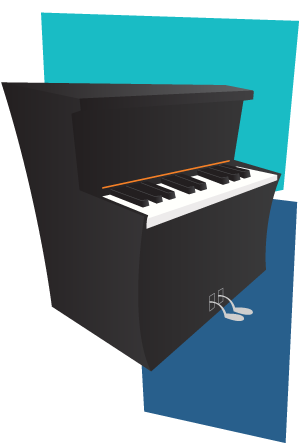from the Meet the Orchestra Index

Hey Kids, It's a Piano
Learn piano history, how it's made, how it's played, and fun facts.
The Piano can be a member of the orchestra or a solo instrument. It is one of the favorite solo instruments of all the instruments in the orchestra with works by Beethoven, Brahms, Gershwin, Mozart, Ravel, Tchaikovsky, and many more. Stravinsky's Petrouchka and Aaron Copland's Appalachian Spring are excellent examples of compositions where the piano plays a role as an orchestra member. The piano player is referred to as a pianist.
The first piano was built as early as 1694 and was invented by Bartolomeo Cristofori of Padua, Italy. The three pianos built by Cristofori that survive today date from the 1720s. The piano replaced the harpsichord as the most popular keyboard instrument of the Romantic era. The piano was first referred to as a pianoforte which means soft (piano) loud (forte) instrument. It was named the pianoforte because, unlike the harpsichord, it allowed the player to control the degree of loudness and softness of a note by the way he/she would strike a key.
Playing the piano often involves the use of all ten fingers and sometimes both of your feet. To make a sound, simply press a key down. The softer or harder and slower or faster the pianist presses a key will determine the sound quality of the note. The three pedals, controlled by the pianist's feet, also change the tone of the piano. They include the damper pedal, the soft pedal, and the sostenuto pedal. The damper pedal is the most used pedal by far, serving to sustain the notes that have been played. The soft pedal, which may be locked in place during a performance, serves to lighten the intensity of the notes. The last pedal, the sostenuto pedal, makes it possible to sustain some notes while allowing the player to play detached sounds on another part of the keyboard.
Grand piano builders begin by coating thin sheets of maple or beech with glue and then layering these sheets until they have enough to form the outer rim of the piano. The layers are then taken to a rim press to give the wood its proper shape. After 24 hours in the press, the glue is dry enough to remove the rim from the press. The contoured rim is then taken to a conditioning room for 30 days to allow additional time for the glue to dry. Next, piano builders add a system of braces and tension rods to make the piano very sturdy. The piano is now ready for the sound board which is the amplifier of the piano. This is the part of the piano where choosing the right wood matters the most. In quality pianos, the sound board is made of solid spruce because of its strength and weight. The sound board and two bridges are placed above the brace system. The piano builder then adds ribs to the sound board, gluing them in place, clamping them tightly, and leaving them to dry. The glue will dry for about an hour. Next, the bridges and cast iron plate are added. Good craftsmanship is very important here. If the sound plate is not correctly assembled, the piano will never work well. The piano then goes through a finishing process where it is sanded and given its final look. In the next step, piano builders add the pin block, pins and steel piano strings. Dampers are then added to stop the strings from vibrating after a note is played. The keys and hammers are added next, carefully checking the action of the keys to insure that they will respond perfectly for the player. Add three legs and three pedals and there you have it... a piano.
By the time a piano is put together it can be quite heavy. A Steinway Concert Grand can weigh up to 990 pounds. The largest piano built, the Fazioli F308, weighs in at a whopping 1520 pounds!
The system described for building the rim of a grand piano was developed by Theodore Steinway in 1880.
Piano playing is sometimes referred to as "tickling the ivories". Have you tickled a piano lately?
Watch a How It's Made - Grand Piano video that will offer your kids a virtual field trip to a piano factory.
Discover the joy of playing the piano with our beginner and easy, free & premium piano sheet music — print instantly!
Piano Sheet Music - Beginner & Easy
No points or streaks—just smarter-kid-building, well-rounded-musician-making progress. That's what you get with MakingMusicFun.net Piano Academy lessons. Get started today!